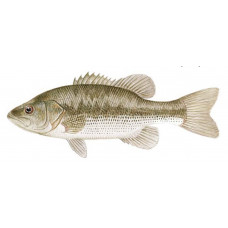Latin name
Micropterus punctulatus
Other names
Alabama spotted bass, black bass, Kentucky bass, Kentucky spotted bass, lineside, northern spotted bass, redeye, spot, Wichita spotted bass.
Identification
Spotted bass has a moderately compressed, elongated body with similar coloration and markings to those of largemouth bass. Both have a light green or brown tint to the back and upper flanks, white lower flanks and belly, and a broad band of diamond-shaped spots along the midline of the body. Like all black bass except the largemouth bass, the spotted bass has scales at the base of the second dorsal fin, its first and second dorsal fins are clearly connected, and the upper jawbone does not protrude backward to or beyond the posterior edge of the eyes. The spotted bass has a distinct with teeth area on the tongue and a large spot on the gill cover. Spotted bass differs from smallmouth bass in that it does not have the vertical stripes that are present on the sides of the body in smallmouth bass. It also has small black spots located in alternating rows under the lateral line (hind edges of some scales are black), unlike largemouth and smallmouth bass. Spotted bass and smallmouth bass have reportedly hybridized in nature, which may make it difficult to identify some specimens where both species occur. Alabama spotted bass has a dark spot at the base of the tail and on the back of the gill cover, and 68 to 75 scales along the lateral line. The northern spotted bass also has a spot on the tail, but the spot on the gill cover is not as distinct, and there are only 60 to 68 scales along the lateral line.
Distribution
The spotted bass were once primarily found in the lower and central Mississippi River in North America, but their range has expanded considerably. They are now found throughout the central and lower Mississippi River basin, from southern Ohio and West Virginia to southeastern Kansas and south to the Gulf of Mexico (from Texas to the Florida Panhandle), including the Chattahoochee Creek in Georgia, Alabama, Tennessee, Kentucky, and other nearby states where they occur naturally or were introduced. The fish have been introduced as far west as California, where some large specimens are now found, and beyond North America, including South Africa, where the species has established itself in several bodies of water. The rarely seen Wichita spotted bass appears to inhabit only West Cache Creek, Oklahoma. Alabama spotted bass are found in Alabama, Mississippi, and Georgia.
Habitat
The spotted bass' natural habitat is clean, gravelly, flowing pools and channels of streams and small to medium-sized rivers, and it also tolerates slower, warmer, and muddy areas in which smallmouth bass are unlikely to be found. They are rarely found in natural lakes, but have adapted well to the deep bodies of water that have been created by damming some natural rivers and streams. Typical habitat is similar to that of largemouth bass, although spotted bass prefers to rocky areas and are much more likely to live and keep in open waters. In some bodies of water, it may stay in deeper water (60 to more than 100 feet). Habitats include rocky bluffs, deep rock piles, and underwater humps.
Size
Spotted bass rarely exceeds 4–5 pounds, rarely seen up to 8 pounds. The world record for all tackle is considered to be a 10 pound, 4 ounce fish caught in California in 2001. Because of the difficulty in recognizing the species, there is a possibility that larger record-breaking specimens of spotted bass have gone unnoticed. Life expectancy is about 7 years, which is much shorter than smallmouth or largemouth bass, and the growth rate is intermediate between the two species.
Life history and Behavior
Spotted bass spawn in spring when water temperatures range from 63° to 68 °F. Males sweep silt from gravel or rock bottoms to make nests, usually near bushes, logs, or other heavy shelters. The males guard the eggs and then guard the fry after they leave the nests. The fry are extremely active.
Food and feeding habits
Juveniles eat small crustaceans and gnat larvae, while adults eat insects, larger crustaceans, minnows, frogs, worms, larvae, and small fish. Crayfish are usually the most important element in the diet, followed by small fish and larval and adult insects.
Reproduction
No information
| Classification | |
| Phylum | Chordata |
| Class | Actinopterygii |
| Squad | Perciformes |
| Family | Centrarchidae |
| Genus | Micropterus |
| Species | M. punctulatus |
| Features | |
| Conservation status | Least Concern |
| Habitat | Pelagic |
| Life span, years | 7 |
| Maximum body weight, kg | 5.2 |
| Maximum length, cm | 64 |
| Sailing speed, m/s | No information |
| Threat to people | Edible |
| Way of eating | Predator |


